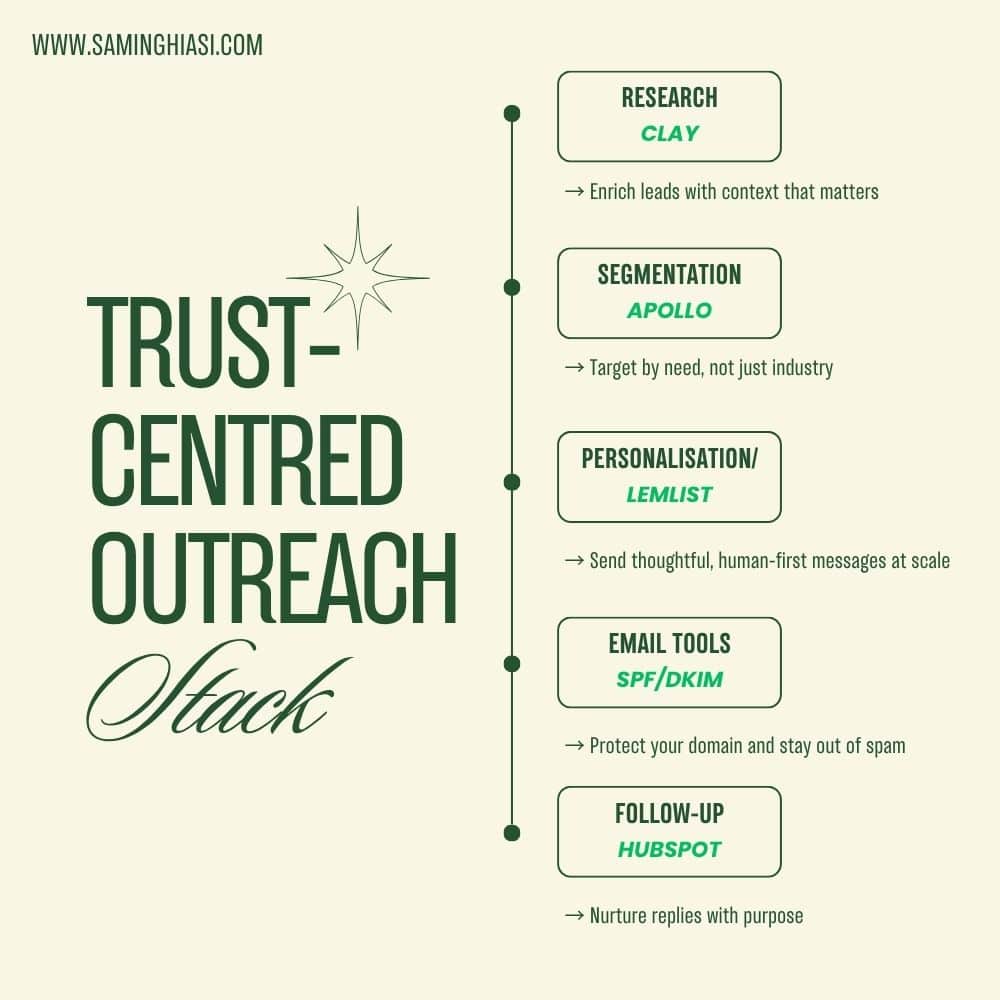Reading time: 7 minutes
“Cold outreach isn’t dead. It’s just evolving.”
For years, cold emails were the domain of spammy subject lines and soulless automation. But in 2025, ethical brands are rewriting the rules.
Bonus post to close out the July blog series on The Growth Ethos. Subscribe here to be updated for September content!
1. Why traditional cold outreach fails (and fast)
Nearly eight in ten B2B buyers say that most of the outreach they receive feels irrelevant or misaligned with their needs [1].
The root issue isn’t just volume, it’s trust erosion. Tactics like fake “follow-ups,” misleading subject lines, or copy-paste introductions have made cold email synonymous with spam.
“Excessive bounce rates and low engagement now threaten your sender reputation more than ever.“
The real cost? Deliverability collapse, brand dilution, and teams wasting hours chasing leads that were never aligned to begin with.
2. The 3 pillars of conscious cold emailing
| Pillar | What it means | Why it works |
|---|---|---|
| Relevance over volume | 10 precise leads beat 1,000 scraped contacts | Fewer unsubscribes, better replies |
| Transparency builds credibility | Say who you are, what you want, and why | Earns attention, not suspicion |
| Offer real value | Educate, invite, support — don’t push | Starts conversations, not rejections |
These aren’t constraints, they’re filters for quality. Ethical is simply smart.
3. From extractive to value-led: cold email examples
❌ The extractive version (don’t do this)
Subject: Quick call?
Hi [FirstName],
I help companies like yours scale. Got 15 minutes this week?
This lacks intent, substance, and reason to reply. No context. No relevance. Just noise.
✅ The conscious version (real tone, real intent)
Subject: Curious how you’re approaching [X]?
Hey [FirstName],
I came across your [recent project/article/post]. I work with ethical brands facing similar [challenge] and thought a short idea might support what you’re building.
Would it be helpful if I sent it over?
Key ingredients: curiosity, context, consent.
This approach acknowledges the recipient’s world before introducing yours; the foundation of respectful outreach.
4. Tooling for authenticity
The right tech stack safeguards your reputation.
- Lemlist – Enables personalisation (images, videos) at scale [2]
- Apollo – For segmentation and cleaner data
- Bouncer – Scrubs lists to prevent spam flags
- HubSpot CRM – Tracks conversations considerately
Also important: Set up your SPF/DKIM records properly. Failing to authenticate your domain can kill deliverability before you send your first email [3].
5. What ethical brands do differently
In conscious outreach, every touchpoint reflects long-term values:
- Ask permission before pitching
- Always include an opt-out (even manually)
- Use copy that has your tone of voice
- Follow up with care, not pressure
- Track engagement that signals trust, not just opens
Pro tip: Link your outreach to something useful, like a short resource or invite,
not a sales deck.
6. Metrics that matter in 2025
These numbers move the needle:
- Reply rate > Open rate
- Positive response rate
- Lead-to-qualified ratio
- Reputable markers – newsletter signups, social shares, return replies
- Unsubscribe rate – yes, track it. A low opt-out rate signals relevance
7. Conscious cold emailing at scale
Ethical outreach is possible, but only when your systems reflect your support.
- Segment by behaviour and values, not just company size
- Don’t add pictures!
- Add human context to every step
- Automate reminders, not relationships
- Only send when there’s a clear reason to reach out (lead socring)
Example:
Instead of pushing a product demo in the first email, share a short audit or insight based on something they published.
E.g.: “I noticed your team launched [X feature] last month — here’s a quick teardown on how similar companies increased adoption post-launch.”
Why it works: It shows you’ve done your homework, offers insight without asking for anything, and invites a thoughtful exchange (rather than a pitch).
Build a community (yes, again)
If you’re building something meaningful, treat outreach as an extension of your product, one that is thoughtful, intentional, and clear.

Respect your reader. Provide a real contribution. And trust that the right leads will respond.
SOURCES
[1] LinkedIn B2B Trends Report 2024 – “Why most cold outreach fails”
[2] Lemlist – “How to personalise cold emails with dynamic visuals”
[3] Google Postmaster Tools – Email authentication best practices
THIS SERIES IS COMPLETE (really, this time)
This bonus post concludes The Growth Ethos — a 10-post exploration of smarter, more sustainable growth in 2025.
If you’re new here, here’s what you’ve missed:
- Part 1: Growth Marketing 101 (2025 Edition): A Conscious Marketer’s Guide
- Part 2: Why Vanity Metrics Are Dying (and What to Track Instead)
- Part 3: How to Build a Sustainable Growth Engine Without Burning Budget (or the Planet)
- Part 4: Circular Growth Loops Are the Future of Ethical Marketing
- Part 5: 6 Martech Tools Every Ethical Brand Should Be Using This Year
- Part 6: From Scarcity to Stewardship: The New Psychology of Conscious Consumers
- Part 7: Dark Social and Micro‑Communities: How Sustainable Brands Are Winning Trust
- Part 8: Sustainable Paid Media: How to Align Ads with Purpose in 2025
- Part 9: SEO for Good: Content That Powers Purpose and Growth
- Part 10: B2B : 5 modèles européens qui réinventent la concurrence
BUILD WITH INTEGRITY
Thanks for following along this summer. If you’re building your community — I’d love to stay in touch.
📬 Subscribe to the newsletter to receive new posts when the next series starts in September.